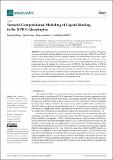Files in this item
Towards computational modeling of ligand binding to the ILPR G-quadruplex
Item metadata
| dc.contributor.author | Zhang, Xiaotong | |
| dc.contributor.author | Barrow, John | |
| dc.contributor.author | van Mourik, Tanja | |
| dc.contributor.author | Bühl, Michael | |
| dc.date.accessioned | 2023-04-19T14:30:01Z | |
| dc.date.available | 2023-04-19T14:30:01Z | |
| dc.date.issued | 2023-04-13 | |
| dc.identifier | 283968719 | |
| dc.identifier | 2c53ecc0-b7fe-43a8-8fad-c27f0b89a4f2 | |
| dc.identifier | 85156114819 | |
| dc.identifier.citation | Zhang , X , Barrow , J , van Mourik , T & Bühl , M 2023 , ' Towards computational modeling of ligand binding to the ILPR G-quadruplex ' , Molecules , vol. 28 , no. 8 , 3447 . https://doi.org/10.3390/molecules28083447 | en |
| dc.identifier.issn | 1420-3049 | |
| dc.identifier.other | RIS: urn:0B828E0CECE79A3774FAE83BFE62CB6E | |
| dc.identifier.other | ORCID: /0000-0002-1095-7143/work/132764132 | |
| dc.identifier.other | ORCID: /0000-0001-7683-3293/work/132764154 | |
| dc.identifier.other | RIS: urn:0B828E0CECE79A3774FAE83BFE62CB6E | |
| dc.identifier.uri | https://hdl.handle.net/10023/27433 | |
| dc.description | Funding: X.Z. wants to thank the Chinese Scholarship Council for funding. | en |
| dc.description.abstract | Using a combination of unconstrained and constrained molecular dynamics simulations, we have evaluated the binding affinities between two porphyrin derivatives (TMPyP4 and TEGPy) and the G-quadruplex (G4) of a DNA fragment modeling the insulin-linked polymorphic region (ILPR). Refining a well-established potential of mean force (PMF) approach to selections of constraints based on root-mean-square fluctuations results in an excellent agreement between the calculated and observed absolute free binding energy of TMPyP4. The binding affinity of IPLR-G4 toward TEGPy is predicted to be higher than that toward TMPyP4 by 2.5 kcal/mol, which can be traced back to stabilization provided by the polyether side chains of TMPyP4 that can nestle into the grooves of the quadruplex and form hydrogen bonds through the ether oxygen atoms. Because our refined methodology can be applied to large ligands with high flexibility, the present research opens an avenue for further ligand design in this important area. | |
| dc.format.extent | 14 | |
| dc.format.extent | 1324872 | |
| dc.language.iso | eng | |
| dc.relation.ispartof | Molecules | en |
| dc.subject | G-quadruplex | en |
| dc.subject | Potential of mean force | en |
| dc.subject | Ligand with high flexibility | en |
| dc.subject | QD Chemistry | en |
| dc.subject | QH301 Biology | en |
| dc.subject | DAS | en |
| dc.subject | MCC | en |
| dc.subject.lcc | QD | en |
| dc.subject.lcc | QH301 | en |
| dc.title | Towards computational modeling of ligand binding to the ILPR G-quadruplex | en |
| dc.type | Journal article | en |
| dc.contributor.institution | University of St Andrews. University of St Andrews | en |
| dc.contributor.institution | University of St Andrews. Centre for Research into Equality, Diversity & Inclusion | en |
| dc.contributor.institution | University of St Andrews. EaSTCHEM | en |
| dc.contributor.institution | University of St Andrews. School of Chemistry | en |
| dc.identifier.doi | https://doi.org/10.3390/molecules28083447 | |
| dc.description.status | Peer reviewed | en |
This item appears in the following Collection(s)
Items in the St Andrews Research Repository are protected by copyright, with all rights reserved, unless otherwise indicated.

